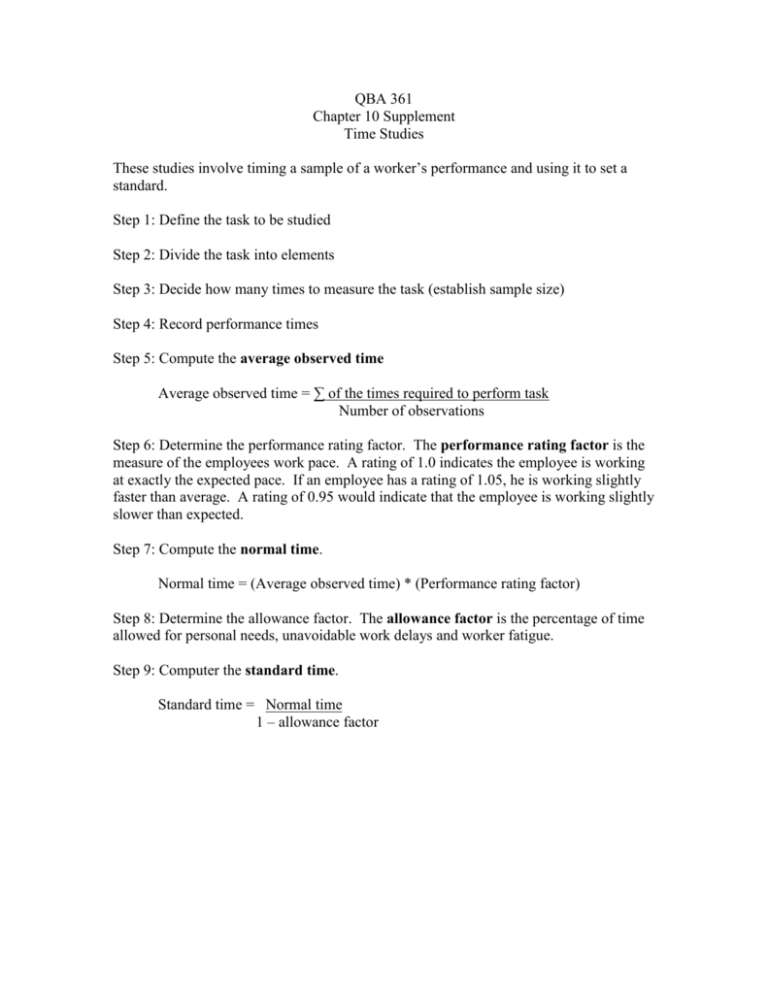Time Studies Writeup - University of Hawaii at Hilo
advertisement

QBA 361 Chapter 10 Supplement Time Studies These studies involve timing a sample of a worker’s performance and using it to set a standard. Step 1: Define the task to be studied Step 2: Divide the task into elements Step 3: Decide how many times to measure the task (establish sample size) Step 4: Record performance times Step 5: Compute the average observed time Average observed time = ∑ of the times required to perform task Number of observations Step 6: Determine the performance rating factor. The performance rating factor is the measure of the employees work pace. A rating of 1.0 indicates the employee is working at exactly the expected pace. If an employee has a rating of 1.05, he is working slightly faster than average. A rating of 0.95 would indicate that the employee is working slightly slower than expected. Step 7: Compute the normal time. Normal time = (Average observed time) * (Performance rating factor) Step 8: Determine the allowance factor. The allowance factor is the percentage of time allowed for personal needs, unavoidable work delays and worker fatigue. Step 9: Computer the standard time. Standard time = Normal time 1 – allowance factor Example Cinnabon, a store in the Prince Kuhio mall, wants to study how long it takes an employee to make a pan of cinnamon rolls. A sample of the employees efforts at making 6 pans of cinnamon rolls showed the employee took from 19 to 25 minutes per pan. Observation 1 2 3 4 5 6 Total observations = 6 Time Recorded (in minutes) 20 23 19 18 24 25 Total time = 129 minutes Average observed time = ∑ of the times = 129 minutes = 21.5 minutes Number of observations 6 observations Lets say the manager judged the employees overall performance to be .85. This suggests that the employee is not working as fast as expected. Lets also say that the company uses a standard allowance factor of .10 (10%). The following measures can now be obtained. Normal time = (Average observed time) * (Performance rating factor) = (21.5 minutes) * (.85) = 18.28 minutes Standard time = Normal time 1 – allowance factor = 18.28 minutes 1 - .10 = 18.28 = 20.31 minutes .90 So, the manager would expect that if the employee were working at 100% (full effort), it would take her 20.31 minutes to bake a pan of rolls. Example (p. 410 in textbook) Time Study Example S2 Allowance factor = 15% Cycle Observed (in minutes) Job Element 1 2 (A) Compose and type letter 8 10 (B) Type envelope address 2 3 (C) Stuff, stamp, seal, and sort envelopes 2 1 1. 2. 3 Performance Rating 4 5 9 21* 11 120% 2 1 3 105% 5* 2 1 110% Delete unusual or nonrecurring observations (marked with *) Compute average cycle times for each element Average time for A = (8 + 10 + 9 + 11)/4 = 9.5 minutes Average time for B = (2 + 3 + 2 + 1 + 3)/5 = 2.2 minutes Average time for C = (2 + 1 + 2 + 1)/4 = 1.5 minutes S10 – 19 © 2006 Prentice Hall, Inc. Time Study Example S2 3. Compute the normal time for each element Normal time = (average observed time) x (rating) Normal time for A = (9.5)(1.2) = 11.4 minutes Normal time for B = (2.2)(1.05) = 2.31 minutes Normal time for C = (1.5)(1.10) = 1.65 minutes 4. Add the normal times to find the total normal time Total normal time = 11.40 + 2.31 + 1.65 = 15.36 minutes © 2006 Prentice Hall, Inc. S10 – 20 Time Study Example S2 5. Compute the standard time for the job Standard time = = © 2006 Prentice Hall, Inc. total normal time 1 - allowance factor 15.36 = 18.07 minutes 1 - .15 S10 – 21











